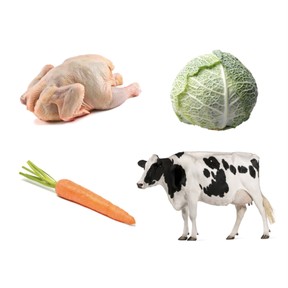
What animals eat: Herbivores, carnivores, omnivores
I can tell the difference between a herbivore, carnivore, and omnivore.



8,000 schools use Gynzy
92,000 teachers use Gynzy
1,600,000 students use Gynzy
General
Students learn the definition of the words "herbivore," "carnivore," and "omnivore," and will identify animals that belong in each of these categories. They will also identify foods that each of these types of animals might eat.
Standards
NGSS:
K-LS1-1
K-ESS3-1
K-ESS2-2
Learning objective
Students will be able to distinguish between herbivores, carnivores, and omnivores.
Introduction
Have students turn and talk to a partner to discuss some of the foods they like to eat. Have the class share some of their favorite foods. Tell students that animals need to eat food just like us, but that there are different animals who only eat certain types of food. Those three types of animals are herbivores, carnivores and omnivores.
Instruction
Start by explaining that herbivores are animals that only eat plants. Give some examples of herbivores and some examples of what they might eat. Continue by explaining that carnivores are animals that only eat meat. Display some examples of carnivores, and some examples of what they might eat. Finish by explaining that omnivores are animals that eat both plants and meat, giving examples of both omnivores, and some of the things they like to eat. Ask students to drag the foods a herbivore would eat into the box on the right. Then ask students to drag the foods a carnivore would eat into the box on the right. Finally ask students to drag the foods an omnivore would eat into the box. Remind students that an omnivore would eat everything! Then read the paragraph about rabbits together as a class. Ask students to determine what type of animal a rabbit is. Repeat this with the paragraph about tigers and then bears. Have students drag the animals into the category herbivore, carnivore, and omnivore.
Quiz
Students are first given a set of true or false questions to check their understanding of key concepts from the text. Next they are given multiple-choice questions in which they must determine the type of animal from a text given, or select whether a given animal is a herbivore, carnivore, or an omnivore.
Closing
Repeat the learning goal with the students and ask them to tell what the different types of animals eat. Ask students to draw lines from the illustrations to the type of animal they represent. To close the lesson, students spin the wheel and answer the questions.
Teaching tips
Since many students have house pets or perhaps the class has a classroom pet- you can always start by discussing the type of animal (herbivore/carnivore/omnivore) it is/they have. Students with cats might also mention that their cats eat grass (or catnip) but you can explain that they don't eat that for survival, but rather for medicinal/play purposes.
The online teaching platform for interactive whiteboards and displays in schools
Save time building lessons
Manage the classroom more efficiently
Increase student engagement
Discover more!
About Gynzy
Gynzy is an online teaching platform for interactive whiteboards and displays in schools.
With a focus on elementary education, Gynzy’s Whiteboard, digital tools, and activities make it easy for teachers to save time building lessons, increase student engagement, and make classroom management more efficient.



